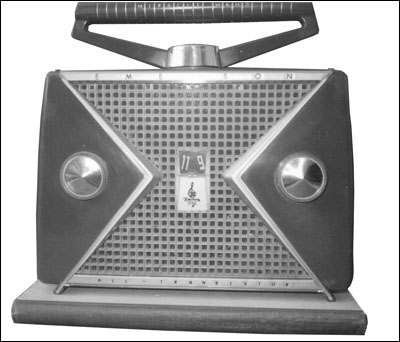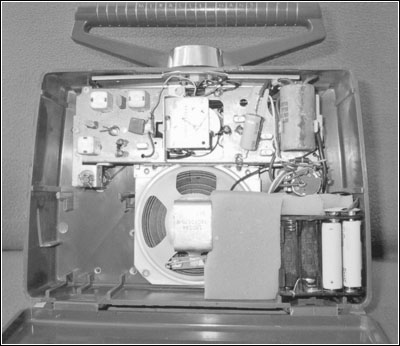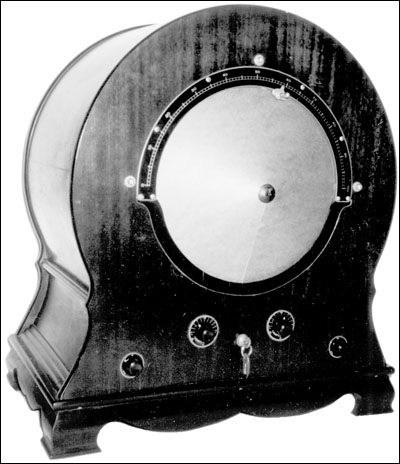Of Old Radios And Related Items--Published Monthly
Emerson Model 847 Transistor Portable
BY ROBERT B. ENEMARK
Web Edition
All "early" radios seem to have a special attraction, be they tube or transistor sets. The Emerson portable described in this article uses plug-in transistors and qualifies as "early" in the world of transistor radio collectors. (Editor)
The 1957 Emerson Model 847, shown in Figure 1, really struck me with its smooth, turquoise plastic appearance and very nice condition when I saw it at the Antique Mall in Queechie, Vermont. So, I bought it, of course.
What stood out when I opened the back cover were the two, dead, 9-volt, No. 276, batteries. When I connected up 9 volts to the battery input, very loud motor-boating rattled the speaker. The 80 mF section of the filter capacitor was bad, so I snipped it out and substituted a 200 uF/25-volt unit. Reconnected, the radio worked nicely and was pretty sensitive.
After that, I installed a Radioshack 8-slot, AA battery holder, jumpering two unused slots to get 9 volts with 6 cells. These modifications are shown in Figure 2. I then easily cleaned and polished the cabinet.
Figure 1. The Emerson Model 847 "All Transistors" with its "Miracle Wand" antenna.
Figure 2. A rear view of the of the Emerson portable with its back cover removed reveals its component layout. The replacement filter capacitor is shown in the upper right corner of the cabinet. The modified battery holder is located at the bottom right.Emerson Radio and Phonograph Corp., located in Jersey City, New Jersey, at that time, took care to use sockets for easy repair in case the transistors went bad. Three RF, NPN transistors for converter and IF stages were used, but strangely, unknown PNP units constituted the driver and push-pull AF amplifiers. All transistors are made by Texas Instruments Corp. and are metal-cased.
The carrying handle on the Model 847 houses Emerson's "Miracle Wand" ferrite loop antenna, which, being fairly large, contributes to the radio's good sensitivity. The schematic is pretty straightforward, and the RF transistors were rated at about 30db gain with a cutoff frequency of 6 MHz. This is a pretty good performance for junction transistors only nine years after point-contact types were invented.
Reference:
Sams Folder, Sheet 5, Set 353, April 1957.
Before retiring in 1980, Robert Enemark, a consulting engineer, specialized in such area as VLF submarine reception, radar countermeasures, military weapons testing, and industrial instrumentation. He has been awarded more than 50 U.S. and foreign patents. A Ham operator since 1941, he collects pre-World War II shortwave sets and telegraph equipment for which he has set up a museum in Duxbury, Mass.
Sprucing Up the Thompson "Minuet" Neutrodyne
BY ROLAND JENNINGS
In the February 1997 issue of A.R.C., Roland Jennings wrote a very comprehensive article about restoring his Thompson Minuet. The following article shares his discovery of a source of cone speakers that would make the job of restoration easier for fellow collectors. (Editor)
Since my article ten years ago on the Thompson "Minuet," I've become an octogenarian, and so I'm wondering why I've considered writing another article. I suppose the reason is quite obvious -- I believe it becomes a duty of sorts to pass on to succeeding generations knowledge gained through diligence, the school of hard knocks, some "been there, done that" situations, and not ruling out a bit of déjà vu.
My "Minuet"
As Ted Baxter, the pompous TV anchorman in the 1970s MTM sitcom would say when asked about his career, "It all started in a small 5000-watt radio station in Fresno, California. Well, I too began my budding career as BC station engineer in a 5000-watt AM'er, although in a different locale. In 1953, as described in my 1997 article, I discovered this rare Thompson Neutrodyne radio while browsing through a mishmash of household items at a neighborhood estate sale in my hometown.
The set appeared to be in good condition, even the exposed paper cone. The cabinet's exterior surface had been the target of an errant paintbrush and received a generous spattering of grey Kemtone, a water-based interior paint marketed in the 1940s. I was able to remove all vestiges of the paint by meticulously chipping it off a speck at a time.
The tapered, disc-like object in the center of the cone serves as a connector between the apex and the speaker driver, a Crosley Musicone. I suppose this could be compared to a "spider," a device used in the electromagnetic speaker era, whose purpose was to hold the voice coil in an accurately centered position. Early photographs of the Minuet indicate that several different disc designs were incorporated. The one on my set is rather plain, yet functional.
Sprucing Up The "Minuet"
Recently, I was in contact with a radio enthusiast and collector from California who was in the midst of restoring his Thompson R-81. This model is similar to my set which has no model number. To complete the project he needed a replacement cone. In lieu of fabricating a cone, as I had done, he opted to look into the possibility of duplicating the ones used on the earlier Minuets.
His efforts were successful. He located Buford Chidester who can reproduce this product complete with a Crosley name emblazoned on the surface of the paper cone. Chidester is well known as the author of the handsome book Classic Cones and may be reached at speakerpeople@comcast.net.
Figure 1. Roland Jennings's Thompson "Minuet."This turn of events prompted me to seek a prefabricated cone also, which upon installation will give my Model R-81 prototype a new look. Though I do not yet have a prefab cone in hand, the fact that such an upgrade is possible may serve to bring other collectors up to date in the world of Thompson Minuet.
My initial article in 1997 seems to have generated considerable interest from collectors and owners of the R-8 nationwide and appears to be gaining momentum. In fact, there is a movement afoot to establish an R.E. Thompson Radio Owners Organization (RETRO).
Roland Jennings worked for 27 years in various communications jobs for the Department of Defense and for 10 years as a broadcast station engineer. He holds a Radio Telephone First Class license, as well as an Amateur Radio General Class license. His collection includes AC/DC sets and Japanese transistor radios.
| [Free Sample] [Books, etc., For Sale] [Subscribe to A.R.C./Renew] [Classified Ads] [Auction Prices] [Event Calendar] [Links] [Home] [Issue Archives] [Book Reviews] [Subscription Information] [A.R.C. FAQ] URL = http://www.antiqueradio.com/Jan08_Enemark_Emerson847.html Copyright © 1996-2007 by John V. Terrey - For personal use only. Last revised: December 27, 2007. For Customer Assistance please contact ARC@antiqueradio.com or call (866) 371-0512 toll free Pages designed/maintained by Wayward Fluffy Publications
Antique Radio Classified |


